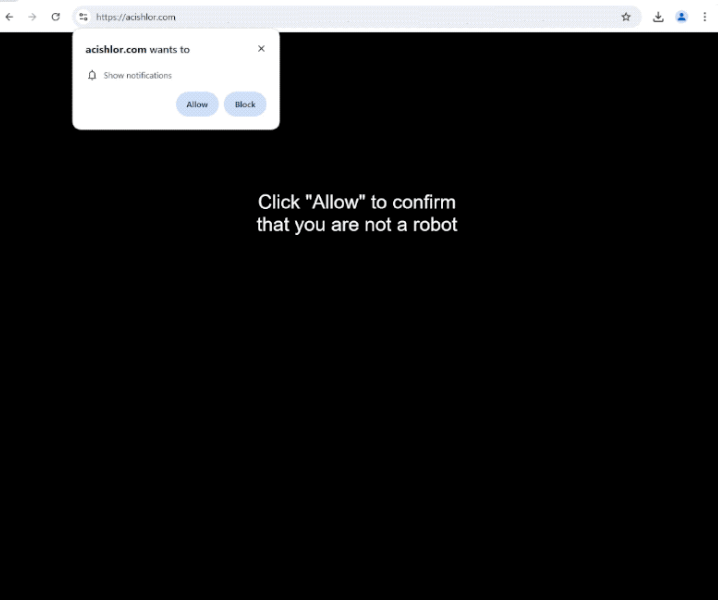Remove acishlor.com notifications
acishlor.com is a generic scam website that tries to trick users into allowing ads on the desktop. It misuses a legitimate browser feature to do this, which is why you will get a browser alert saying “acishlor.com wants to show notifications” when you get redirected to the site. This feature allows sites to request permission to show notifications on users’ desktops. However, instead of useful content, acishlor.com shows highly questionable ads. If you click “Allow”, do not interact with acishlor.com ads and revoke the permission as soon as possible.
When you get redirected to the site, the only thing you will see is a black screen and a message saying you need to confirm you’re not a robot by clicking “Allow”. Your browser will display an alert stating, “acishlor.com wants to show notifications”. It’s best not to engage with anything on that site. If you click “Allow”, you’ll start receiving a barrage of ads on your desktop. These ads can look like authentic system notifications, which is problematic. For example, acishlor.com might show misleading alerts about viruses that appear credible. Such fake virus alerts could promote questionable software or even result in malware infections.
The “show notifications” feature is legitimate and has its uses. You can choose to receive notifications from trustworthy websites, like reputable news outlets, for easy access to their content. Clicking on the notifications would take you directly to the content. When you no longer want to see the notifications, you can easily revoke this permission through your browser settings.
While it’s uncommon, frequent redirects to random sites like acishlor.com could mean that an adware infection is present on your computer. We recommend scanning your computer with an anti-virus program like WiperSoft to check. And if you’ve granted the site permission to show you notifications, be sure to revoke that access. If you need instructions on how to do this, they are available at the end of this report.
What triggers redirects to sites like acishlor.com?
There are two primary triggers for redirects to sites like acishlor.com. Less commonly, these redirects can be linked to adware infections. This is usually accompanied by other symptoms as well. More often, redirects happen when users browse ad-heavy sites without an adblocker program installed. Websites featuring adult or pirated content tend to be particularly ad-heavy, bombarding users with a barrage of advertisements no matter what users click on. Fortunately, using any decent adblocker program can effectively block these redirects and intrusive ads in general.
Adware could also be the trigger. While adware infections are generally minor and don’t directly harm your computer, they are very annoying. Adware, browser hijackers, and similar infections are usually installed by users through a method called software bundling. This method allows unwanted programs to be added to popular free programs as optional offers, which are set to install by default without the user’s clear agreement. Although these offers are technically optional, they often go unnoticed as they are hidden in settings that users rarely use. This is why software bundling is a controversial installation method. Programs that use it are often detected as potential threats by anti-virus programs.
To prevent unwanted installations, all you need to do is pay attention when installing free programs. The installation window will recommend Default settings, but selecting these will automatically grant permission for all additional offers to be installed. Instead, opt for Advanced (Custom) settings, which will list all offers, allowing you to uncheck those you wish to not install. Keep in mind that legitimate programs do not use this installation method.
How to stop acishlor.com notifications?
Using the WiperSoft anti-virus program to scan your computer for any adware infections is a good idea. Removing adware is much simpler with an anti-virus program compared to doing it manually. Additionally, if you haven’t done so already, make sure to install an adblocker program.
If you have allowed acishlor.com to send you notifications, make sure to revoke that permission in your browser settings. If you need assistance with your browser settings, you can find instructions below.
- For Mozilla Firefox: Open Menu (the three bars top-right corner) -> Options -> Privacy & Security. Scroll down to Permissions, press Settings next to Notifications, and remove acishlor.com and any other questionable websites. You can permanently turn off these notification requests by checking the “Block new requests asking to allow notifications” box in the same Notifications settings.
- For Google Chrome: Open Menu (the three dots top-right corner) -> Settings -> Privacy and security -> Site Settings. Click on Notifications under Permissions, and remove acishlor.com and any other questionable websites. You can stop these notification requests permanently by toggling off “Sites can ask to send notifications”.
- For Microsoft Edge: Open Menu (the three dots top-right corner) -> Settings -> Cookies and site permissions -> Notifications. Review which sites have permission and remove acishlor.com and any other questionable websites. You can permanently turn off these notification requests by toggling off “Ask before sending”.
Site Disclaimer
WiperSoft.com is not sponsored, affiliated, linked to or owned by malware developers or distributors that are referred to in this article. The article does NOT endorse or promote malicious programs. The intention behind it is to present useful information that will help users to detect and eliminate malware from their computer by using WiperSoft and/or the manual removal guide.
The article should only be used for educational purposes. If you follow the instructions provided in the article, you agree to be bound by this disclaimer. We do not guarantee that the article will aid you in completely removing the malware from your PC. Malicious programs are constantly developing, which is why it is not always easy or possible to clean the computer by using only the manual removal guide.

